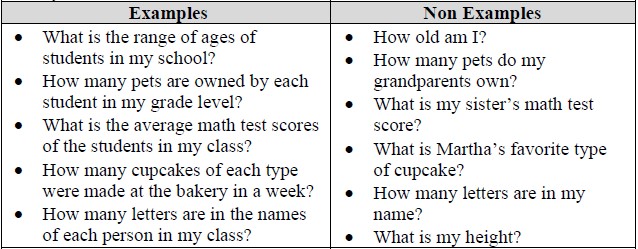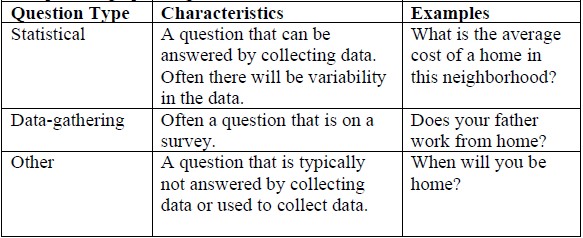General Information
Benchmark Instructional Guide
Connecting Benchmarks/Horizontal Alignment
Terms from the K-12 Glossary
- Data
- Statistical Question
Vertical Alignment
Previous Benchmarks
Next Benchmarks
Purpose and Instructional Strategies
In elementary grades, student collect numerical and categorical data to construct tables and graphs. In grade 6, students are formally introduced to statistical information and formulating statistical questions for numerical data. In grades 7 and 8, students will extend this when working with categorical data and then with bivariate data (MTR.1.1, MTR.4.1).- Statistics are numerical data relating to a group of individuals; statistics is also the name for the science of collecting, analyzing and interpreting such data. It is a method for translating a real-world context into a collection of numbers. A statistical question anticipates an answer that varies from one individual to the next and is written to account for the variability in the data. Data are the numbers produced in response to a statistical question. Data are frequently collected from surveys or other sources (i.e., documents).
- Instruction focuses on statistical questions that generate numerical data. Once the data is gathered, it can be organized in a table or displayed in a graph.
- Instruction includes the understanding of a statistical question and a non-statistical question. A statistical question can be answered by collecting information that addresses differences in a population. A statistical question concerns some characteristic of a collection of individuals rather than of one specific individual.
- For example, the question “How tall am I?” is not a statistical question because there is only about a single individual and there is only one response; however, “How tall are the students in my class?” is a statistical question since it can be answered by gathering information from many students and it is anticipated that this information will vary from one student to the next.
- Survey questions can be used to collect data to gather information for a statistical question.
- For example, the questions “What are the shoe sizes of the students in your class?” and “What is the average shoe size of the students in your class?” can be construed as statistical questions if your students are to gather the data to try to answer them. They might gather this data by asking the survey question “What is your shoe size?”


- For example, the questions “What are the shoe sizes of the students in your class?” and “What is the average shoe size of the students in your class?” can be construed as statistical questions if your students are to gather the data to try to answer them. They might gather this data by asking the survey question “What is your shoe size?”
- For numerical data, statistical questions can result in a narrow or wide range of numerical values. To collect this information, students design a survey question that anticipates variability by providing a variety of possible anticipated responses that have numerical answers, such as 3 hours per week, 4 hours per week and so on. Be sure questions have specific numerical answers.
- Well written statistical questions refer to the following two aspects: population of interest, measurement of interest, and such a question anticipates answers that vary.
- Instruction includes students determining how statistical questions imply that there was data gathered in order to determine a measure of center or measure of variation.
- For example, the statistical question “How much money does a household in Lake County generally spend on internet in a year?” implies that one must gather numerical data on the cost of internet for households in Lake County to determine how much is generally, or on average, spent.
- Instruction includes the understanding that statistical questions are not limited to data that can be gathered by students themselves.
- For example, the question “What are the ten largest cities in Florida?” can be considered a statistical question because data was collected to determine this.
Common Misconceptions or Errors
- Students may believe that all the questions that they write are statistical questions. Students need to understand that a statistical question must have a range of numerical answers. They will need to have sample questions and practice writing their own.
- Students may think that a survey question is a statistical question, since a survey question can be used to answer a statistical question. A statistical question concerns a population. A survey question is asked of individuals in a population to help answer a statistical question.
Strategies to Support Tiered Instruction
- Teacher provides a list of examples of statistical questions and what qualifies them as statistical to assist students who incorrectly label non-statistical questions.
- Teacher provides simple examples that show how a statistical question concerns an entire population and a survey question concerns an individual within a population. Survey questions can be used to gather data to answer statistical questions.
- For example, the statistical question “What is the average height at your school?” can be answered by gathering data using the survey question “What is your height?”.
- Teacher provides instruction focused on patterns that make statistical questions and how to change non-statistical questions into statistical questions. Teachers work with students on examples to determine if each question is statistical or non-statistical. If the question is non-statistical, teacher models how they can convert it to be a statistical question.
- Teacher provides a list and co-constructs a graphic organizer and determines the pattern from statistical and non-statistical questions. Students will have opportunity to explain why each one is either statistical or non-statistical.
- For example, “What are the ten largest cities in Florida?” can be considered a statistical question because one must gather data on all of the cities in the state of Florida. A survey question that can be used to answer this statistical question is “What is the population of your city?”
- For example, “How many movies did you watch last month?” can be considered a survey question which can be used to answer various statistical questions like “What is maximum and minimum number of movies watched last month?” or “What is the average number of movies watched last month by 6th graders?”
- Example of a graphic organizer is shown below.

- Teacher provides sample questions and models how to practice writing their own.
Instructional Tasks
Instructional Task 1 (MTR.7.1)Write a statistical question that will require data that could be collected from your class to provide information to an advertising agency for teenagers to purchase clothing, shoes, backpacks or school supplies.
- a. Design a table for data collection.
- b. Create a proposal to the advertising agency to recommend an item to advertise based on the data you collected from your statistical question. Include data to support your recommendation.
Instructional Items
Instructional Item 1Amir collected data from his sixth-grade class at Liberty Middle School. He asked about the amount of time students spent playing video games. Write a statistical question associated with his data.
Instructional Item 2
Which of the questions below are statistical?
*The strategies, tasks and items included in the B1G-M are examples and should not be considered comprehensive.
